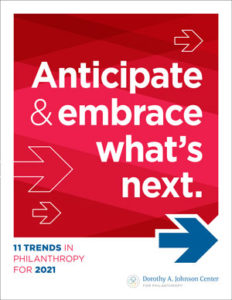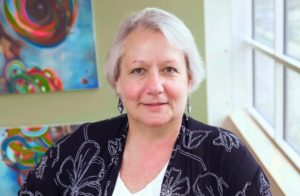Increasing Attention to How Much and Where Money Flows — or Doesn’t


 For decades, challenging questions have been raised about the power dynamics within philanthropy. Who benefits? Which needs and communities are given priority? And most contentiously, how much funding is being distributed? While these questions are not new, today they are being pressed more urgently by social justice leaders, sector critics, and even major philanthropists and foundation leaders. The multifaceted crisis confronting the U.S. and the world in 2020 amplified calls to move beyond questions to demands for meaningful change in the distribution of philanthropic resources, specifically, more grant dollars, to more diverse organizations, with more autonomy for grantees.
For decades, challenging questions have been raised about the power dynamics within philanthropy. Who benefits? Which needs and communities are given priority? And most contentiously, how much funding is being distributed? While these questions are not new, today they are being pressed more urgently by social justice leaders, sector critics, and even major philanthropists and foundation leaders. The multifaceted crisis confronting the U.S. and the world in 2020 amplified calls to move beyond questions to demands for meaningful change in the distribution of philanthropic resources, specifically, more grant dollars, to more diverse organizations, with more autonomy for grantees.
The most intense debates are occurring over the crucial question of how much funding is being distributed. As Collins provocatively states, “Over $1 trillion is parked in private foundations and another $120 billion in donor-advised funds” (2020, para. 4). Some participants in this debate have called for voluntary measures that entail a greater distribution of resources in response to the public health emergency and consequent economic crisis, and others are calling for congressional action.
One example is the #HalfMyDAF challenge, wherein David and Jennifer Risher and other donors offered to match donations made by anyone with a DAF who committed to donating half of their holdings: “We want to help transform DAFs from being enormous parking lots into being funding superhighways, supporting nonprofits now, when they need it most” (2020, para. 3).
The Giving Pledge celebrated its tenth anniversary in August of 2020. Aimed at billionaires, members are asked to pledge half of their wealth to charitable causes and to write an open letter explaining their motivation. In its first decade, membership increased to over 200 from 40 and the number of nations represented grew to two dozen from only the U.S. During that time, the number of billionaires in the world has also steadily climbed, as have their assets and share of the world’s wealth (Collins & Flannery, 2020).
Rather than aiming at established billionaires, other efforts have focused on creating a corporate culture of philanthropy. The Founder’s Pledge, launched in London in 2015, targets the young founders of tech start-ups and emphasizes effective altruism. “By joining now, you send a powerful signal to the startup ecosystem: impactful giving should be the norm, not the exception” (para. 8). They have 1,500 members and over $3 billion pledged. Spearheaded by Salesforce and formally launched in 2014, Pledge 1% encourages companies to commit 1% (in any combination of product, equity, profit, or time) to philanthropy and provides tools to facilitate that commitment. More than 8,500 companies, from AAKonsult to Zylo, in 100 countries have signed on (2018, para. 9).
Yet another strategy for encouraging giving is to shine a light on giving by high-net-worth individuals. Global Citizen’s Give While You Live campaign teamed up with Forbes magazine to score how generous the wealthiest 400 Americans are (McCarthy, 2020; Dolan, Peterson-Withorn, & Want, 2020).
“The multifaceted crisis…in 2020 amplified calls to move beyond questions to demands for meaningful change in the distribution of philanthropic resources, specifically, more grant dollars, to more diverse organizations, with more autonomy for grantees.”
The compelling contrast between the philanthropy of Amazon founder Jeff Bezos and his ex-wife, Mackenzie Scott, provides a current example of the focus on giving by the ultra-wealthy (Dolsak & Prakash, 2020). Bezos has faced criticism for his limited philanthropy and for not signing the Giving Pledge, although he has launched a multi-billion-dollar, multi-year initiative to address climate change. Scott not only signed the Pledge, but over a four-month period in late 2020, she donated $4.2 billion dollars to organizations that serve people who are struggling economically, including historically Black colleges and universities, community development financial institutions, and organizations that advocate for civil rights and serve basic needs (Wamsley, 2020). Most of these grantees did not even know they were being considered for a grant.
Those who want to move beyond encouragement to policy reform have found greater traction. Ray Madoff, a professor at Boston College Law School, and John Arnold, a billionaire and philanthropist, have teamed up to launch the Initiative to Accelerate Charitable Giving (2020). They are calling upon Congress to enact reforms that would mandate that more philanthropic holdings are distributed more quickly to working charities. In addition to other academics and individual philanthropists, their membership includes some of the nation’s largest foundations, including the Ford Foundation, the Hewlett Foundation, Wallace Global Fund, the W.K. Kellogg Foundation, and The Kresge Foundation.
There are important challenges to these proposed reforms, including the argument that accelerated spend-down requirements will leave the philanthropic sector disadvantaged when confronted with its next large-scale challenge (e.g., Council on Foundations, n.d.). Research by the Johnson Center and Plante Moran shows that increasing payout requirements will likely result in a long-term decline in available grant funds (Williams, Veach, & Kienker, 2020).
Besides the question of who is giving how much, the question of who benefits from that giving is coming under increasing scrutiny. Philanthropy has long faced criticism for being a tool for wealthy individuals to support causes that benefit those like them, and recent data show that seven of the top ten grant recipients were elite universities (Candid, 2020).
Increasingly, questions are now being raised about why more resources are not going to BIPOC-led organizations. Activist and noted author of Decolonizing Wealth Edgar Villanueva draws a direct connection between the accumulation of great wealth, the impoverishment of BIPOC communities, and the need for philanthropic resources to be mobilized as a form of reparations to advance social justice (Villanueva & Collins, 2020). The National Center for Responsive Philanthropy released Criteria for Philanthropy at Its Best in 2009 to focus attention on who benefits from philanthropy (Jagpal). While controversial at the time, it has indeed helped change the conversation. However, in a recent study, they found that only 1% of grantmaking from the 25 community foundations they examined was specifically designated for Black communities, even though a combined 15% of these 25 cities’ populations are Black (Barge et al., 2020). A recent study by Echoing Green and the Bridgespan Group found that within Echoing Green’s applicant pool of young organizations, “revenues of the Black-led organizations are 24 percent smaller than the revenues of their white-led counterparts, and the unrestricted net assets of the Black-led organizations are 76 percent smaller than their white-led counterparts” (Dorsey, Brachach, & Kim, 2020, para. 6).
While these studies have been criticized for methodological limitations, leading foundations, including Ford and W.K. Kellogg have embraced measures to promote greater racial equity in their grantmaking. CHANGE Philanthropy has compiled a list of resources and reports about the need for increased investment in marginalized communities. A scan of the list shows how the number of publications has expanded rapidly in recent years. Many were added in 2020 as the uprising in response to the deaths of George Floyd, Breonna Taylor, Ahmaud Arbery, and too many others, prompted foundations to adopt or accelerate their embrace of practices focused on diversity, equity, and inclusion in their grantmaking and operations.
But the questions of how much and to whom aren’t the only pressing issues. The field continues to debate how that money is given out, from application processes that effectively exclude many smaller, newer, and BIPOC-led organizations, to reporting requirements that seem unduly burdensome.
Although foundations can play many roles in creating social change — convenor, organizer, agenda-setter, etc. — grant dollars are still a critical tool. During this tumultuous time, many actors in philanthropy have begun to not only ask tough questions but to make meaningful changes in their practices. Regulatory reform could be coming. We’ll be monitoring which of these changes remain in place and whether they achieve their desired impact as we move through this time of crisis.


Barge, B., Collins-Calhoun, B., Garcia, E., Lewis, J., Richmond, J., Schlegel, R., Ozer, S., & Peng, S. (2020, August 26). Black funding denied: Community foundation support for Black communities. NCRP. https://www.ncrp.org/2020/08/black-funding-denied.html
Candid. (2020, April). Key facts on U.S. nonprofits and foundations. https://www.issuelab.org/resources/36381/36381.pdf
CHANGE Philanthropy. (n.d.). Publications. https://changephilanthropy.org/resource-hub/publications
Collins, C. (2020, June 10). Move charity dollars to the frontlines. Inequality.org. https://inequality.org/great-divide/charity-dollars-front-lines
Collins, C., & Flannery, H. (2020, August 4). Voices from the field: Giving Pledge at 10, peril and possibility. Nonprofit Quarterly. https://nonprofitquarterly.org/voices-from-the-field-giving-pledge-at-10-peril-and-possibility
Council on Foundations. (n.d.). Policy brief: Foundation payout and the COVID-19 crisis. https://www.cof.org/content/policy-brief-foundation-payout-and-covid-19-crisis
Dolan, K., Peterson-Withorn, C., & Wang, J. (2020). The Forbes 400. Forbes. https://www.forbes.com/forbes-400
Dolsak, N., & Prakash, A. (2020, December 16). Different styles of philanthropy: MacKenzie Scott and Jeff Bezos. Forbes. https://www.forbes.com/sites/prakashdolsak/2020/12/16/different-styles-of-philanthropy-mackenzie-scott-and-jeff-bezos
Dorsey, C., Bradach, J., & Kim, P. (2020, May 4). Racial equity and philanthropy: Disparities in funding for leaders of color leave impact on the table. Echoing Green and The Bridgespan Group. https://www.bridgespan.org/insights/library/philanthropy/disparities-nonprofit-funding-for-leaders-of-color
Initiative to Accelerate Charitable Giving. (2020). About us. https://acceleratecharitablegiving.org/about
Jagpal, N. (2009). Criteria for philanthropy at its best. National Center for Responsive Philanthropy. https://bjn9t2lhlni2dhd5hvym7llj-wpengine.netdna-ssl.com/wp-content/uploads/2016/10/paib-fulldoc_lowres.pdf
McCarthy, J. (2020, September 9). New Forbes 400 philanthropy score could help jump-start billionaires’ charitable giving. Global Citizen. https://www.globalcitizen.org/en/content/forbes-400-philanthropy-score
Pledge 1%. (2018, November 27). Global nonprofit that has helped ignite over a billion dollars in philanthropy to ring the Nasdaq stock market opening bell in celebration of 4th anniversary and to honor members and founding builder. https://pledgeitforward.today/global-nonprofit-that-has-helped-ignite-over-a-billion-dollars-in-philanthropy-to-ring-the-nasdaq-stock-market-opening-bell-in-celebration-of-4th-anniversary-and-to-honor-members-and-founding-builder
Risher, D., & Risher, J. (2020, June 9). #HalfMyDAF. https://www.halfmydaf.com
The Founder’s Pledge. (n.d.). Finding solutions. Funding impact. https://founderspledge.com
The Giving Pledge. (2020, December 21). The Giving Pledge welcomes 13 new signatories: Global community now includes philanthropists from 24 countries. [Press release]. https://givingpledge.org/PressRelease.aspx?date=12.21.2020
Villanueva, E., & Collins, C. (2020, September 29). Opinion: It’s time for wealthy donors to embrace reparations, not more charity. MarketWatch. https://www.marketwatch.com/story/its-time-for-wealthy-donors-to-embrace-reparations-not-more-charity-11601384684
Wamsley, L. (2020, December 16). MacKenzie Scott has donated more than $4 billion in the last 4 months. NPR. https://www.npr.org/2020/12/16/947189767/mackenzie-scott-has-donated-more-than-4-billion-in-last-4-months
Williams, J., Veach, C., & Kienker, B. (2020). An Evaluation of Private Foundation Model Portfolios, Investment Returns, & Payout Rates. Council of Michigan Foundations. https://www.michiganfoundations.org/resources/evaluation-private-foundation-model-portfolios-investment-returns-and-payout-rates